
Understanding Guitar Grounding
Practicing your guitar makes you a better guitar player. Understanding guitar wiring makes you a better Tone Wizard. And, properly grounding your guitar’s electronics makes your guitar as quiet as it can be. In today’s article, we will delve into the world of grounding: The basics, common myths, and best practices!
THE BASICS
A Ground (or Earth) connection is a term that relates to a multitude of topics related to electrical engineering. For our intents and purposes, a proper Ground connection is an essential part of your guitar’s wiring. A Ground Connection connects every piece of metal on your guitar and acts as a return path to the amp. In part, the Guitar’s Ground Connection helps remove unwanted noise, and is essential for safety – It allows electricity to travel safely to the amp to dissipate.

Your guitar is surrounded by many things that emit or produce EMI, or electromagnetic interference. Look around you – you’re probably in front of a computer, near some lighting, and most likely close to some electrical lines.
These are all sources of EMI, and there are thousands of them all around us. Your guitar will pick up a multitude of these. However, if you properly ground your guitar, you can get your guitar as quiet as it can be (single coils will still hum), and not introduce sound via improper grounding.
GUITAR GROUNDING MYTHS
There are a few Guitar Grounding Myths that we want to dispel:
MORE IS BETTER:
Definitely not. Proper grounding means it only needs to connect correctly to the ground once. Grounding items multiple times creates a few problems. For one, using wire to ground a series of pots in a circle creates a one-turn coil. If you’ve checked out our article on humbuckers, then you know that EMI usually enters the coil, not through the magnetic field. Creating a loop of ground connections will introduce noise into your signal.
Take a look at the following images. You’ll see an incorrect and proper way to ground a Gibson Les Paul®.

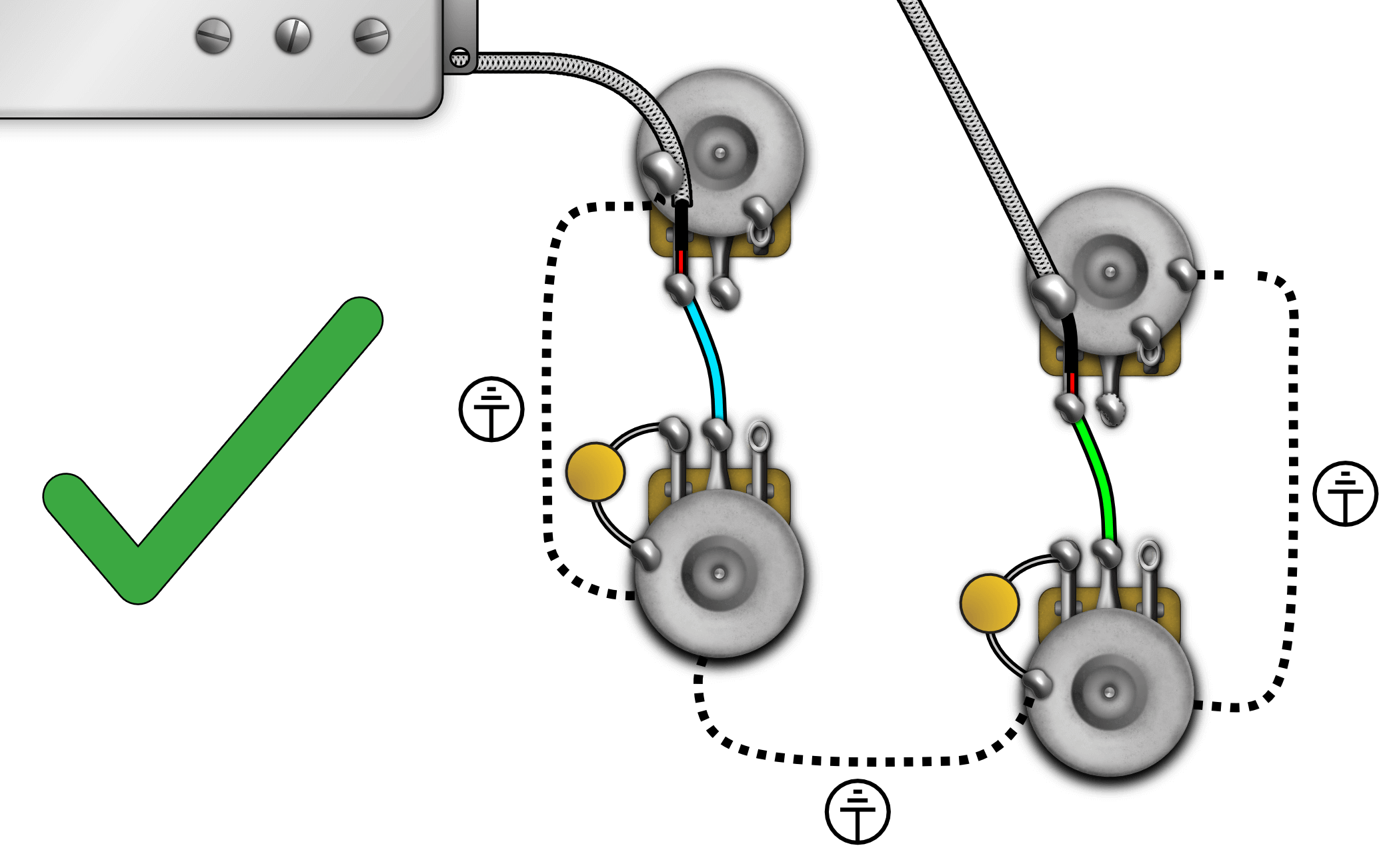
YOU GROUND OUT THE STRINGS
Grounding your strings is essential for having a quieter guitar. If you’ve ever noticed your guitar’s noise gets quieter when you touch the strings, you might have thought your body grounds your guitar’s parts. You’d be wrong if you did. It turns out, a human being makes a pretty good EMI (Electromagnetic Interference) antennae! Your body is an antenna for all sorts of EMI, so when you touch your guitar strings, the guitar is grounding you! Pretty cool, right?
“STAR” GROUNDING: GOOD OR BAD?
Star Grounding refers to the method of grounding that connects all grounds to a Single Point. For example, think of the back of a Strat Volume Pot: It tends to be a central hub for ground connections. Some electrical engineers state that Star Grounding doesn’t make a difference, but Lindy prefers this method. His reasoning? All ground connections connect to the output jack sleeve anyway. Also, it’s harder to create a ground loop by practicing Star Grounding.
BEST PRACTICES
CONNECT EVERYTHING, BUT CONNECT IT ONCE.
Take a look at the following image of a Strat – notice how each part connects to ground once. Notice any jumpers? The Shielding on the back of the pickguard is connecting everything. If you were to add jumpers between pots, you’d be creating a “Ground Loop,” and introducing noise into your circuit.
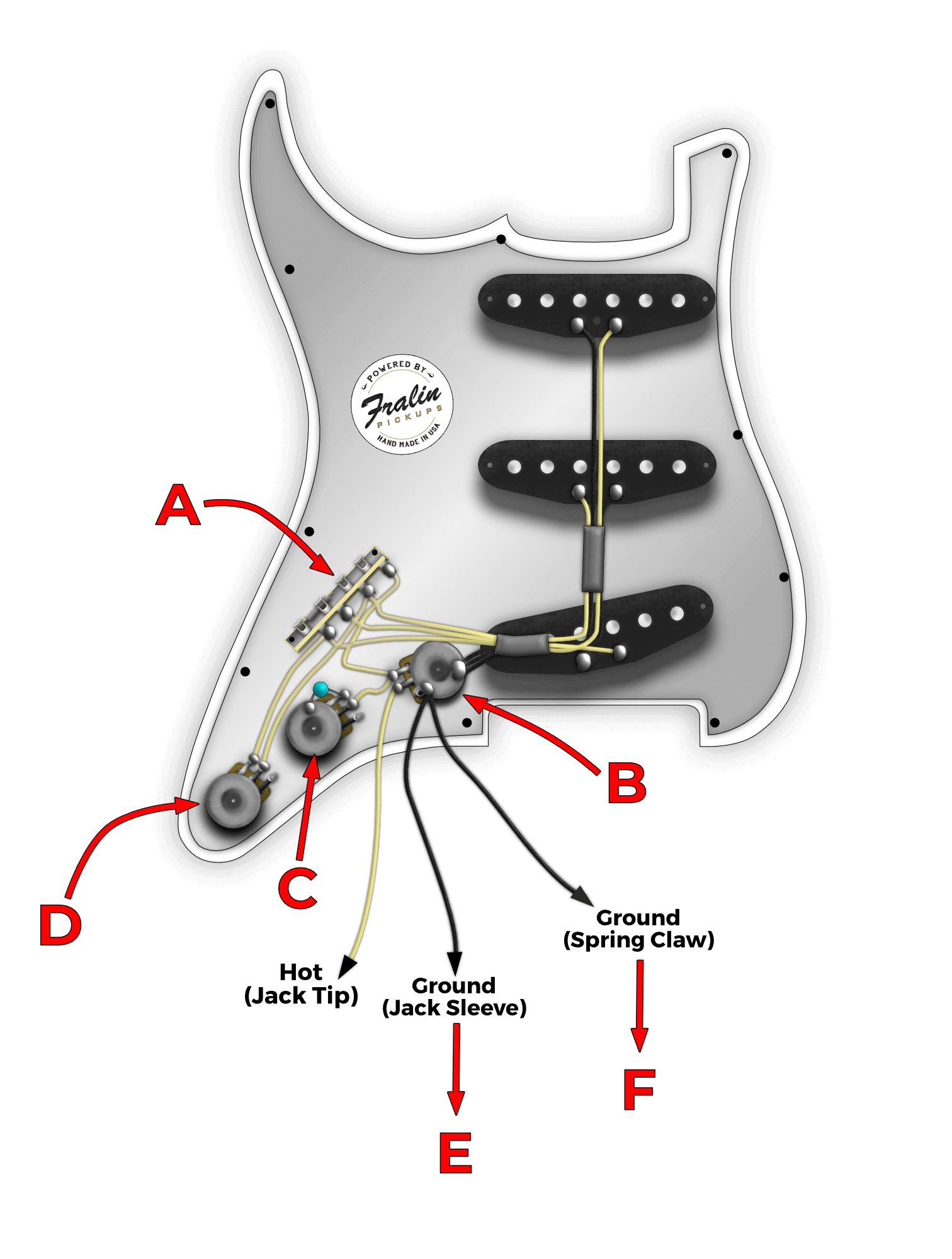
This is a method of “Star Grounding”. You can see that the Volume Pot is more or less a central hub for all points of ground contact. Adding more ground jumpers to the parts will create more ground paths, and introduce noise. However, there’s one main output – the Output Jack’s sleeve. If your pickguard does not have shielding: you’ll need to add shielding or jumpers to ground your guitar’s electronics.
PAY ATTENTION TO YOUR SURROUNDINGS
A lot of grounding mistakes come from not checking your surroundings. If your parts mount to a metal plate or shielding, chances are, they are already connected electronically. In this situation, running extra jumper wires would only over-ground your electronics.
The Telecaster Control Plate pictured below is connecting all electronics. By connecting only one ground wire from the Volume Pot to the Output Jack, you ground your parts thoroughly.
See below:
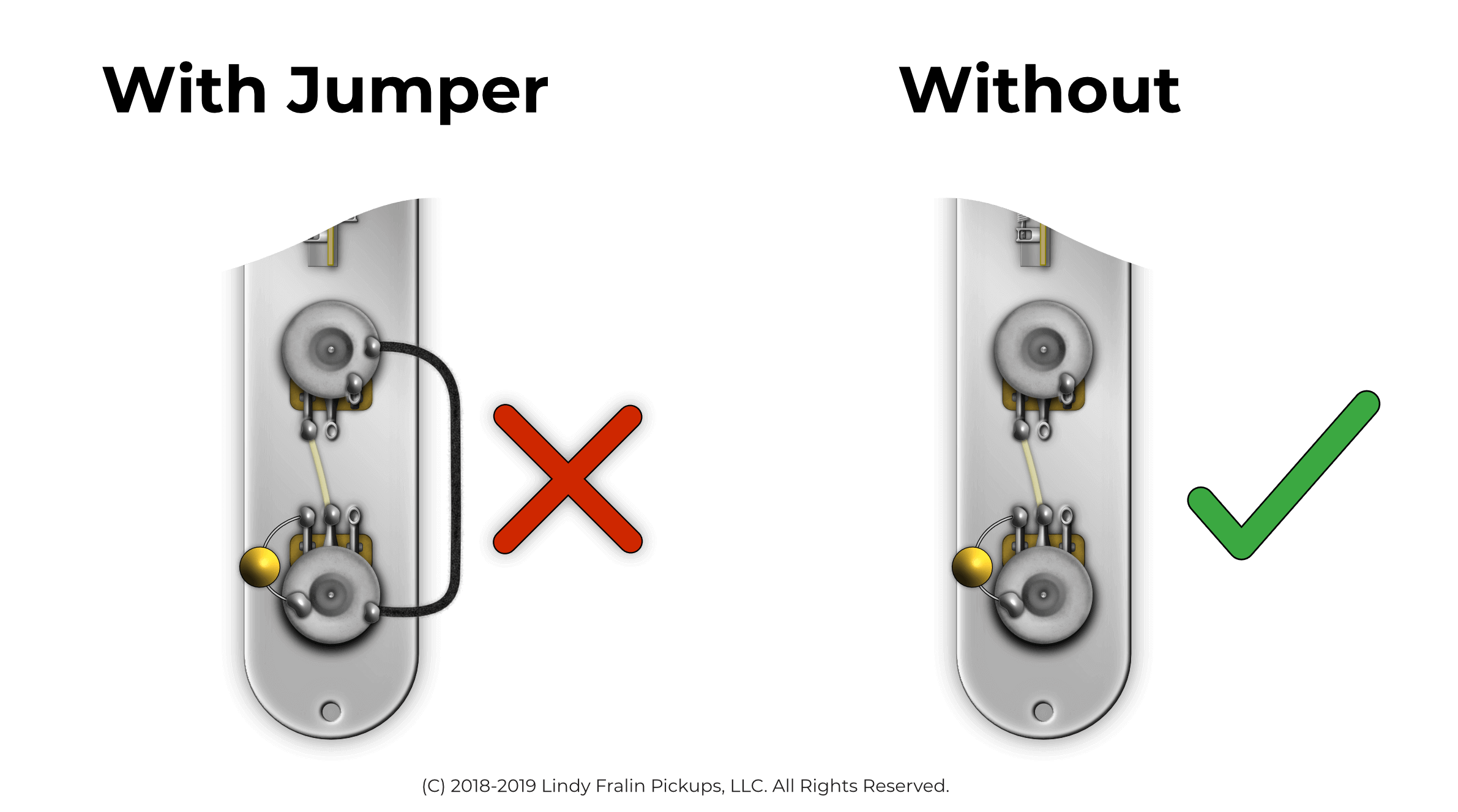
If your bridge pickup’s screws thread into the steel plate like ours do, then that should be enough to ground out your strings, since the steel plate connects to ground. Furthermore, double-check to make sure there are no stray ground wires wedged under the Saddle Plate.
HUNTING DOWN GROUND PROBLEMS
If you’re experiencing Ground problems on your guitar, there’s an effortless way to hunt them down. If you don’t own one already, invest in a Multimeter – you can purchase a decent one for $25. Follow the following steps here:
- With your guitar’s electronic cavities open, turn your multimeter to the D.C. Resistance setting, about 20K.
- Hold one terminal on the back of the volume pot, (B on the above strat pickguard image)
- Use the free terminal to touch every metal piece, and pay attention to the reading of the Multimeter.
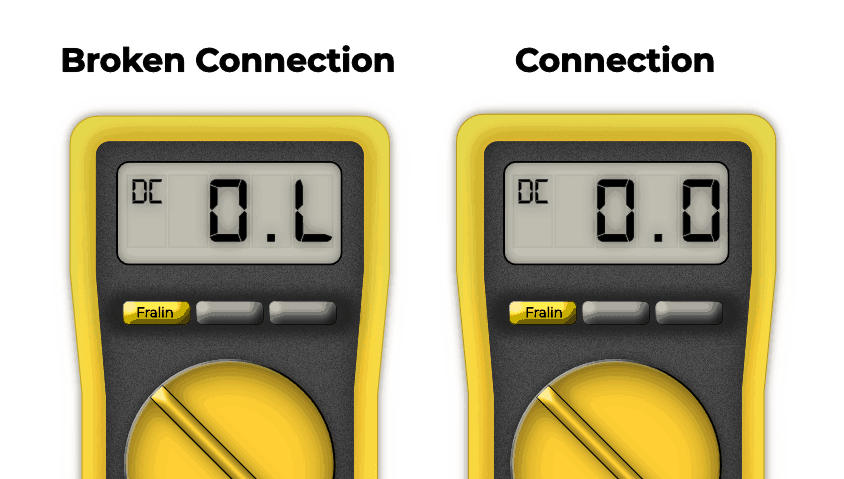
If your Multimeter reads “0.0”, you have a solid connection – there is zero resistance between the two parts. If your Multimeter reads “0.L”, you have a severed connection, and this is at least one of your problems. You’ll need to run a ground jumper to make sure the part gets appropriately grounded.
Note: Make sure you perform this on every part of the guitar, including the Bridge, Switch, and Output Jack Sleeve Tab.
Note 2: If everything checks out in your guitar, start looking at your cable. Check to make sure that your cable’s sleeve is correctly attached to ground.
Lastly, Note 3: If you have Shielding or Conductive Paint, make sure that there is a connection to ground.
That should just about do it for now! Grounding is very simple: make sure everything is grounded, but only once. Don’t overthink it!
Comments
81 Comments For This Post
Leave A Comment
Want to chime in to the conversation? Please do so! Please respect others.

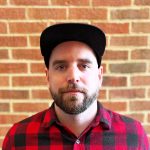

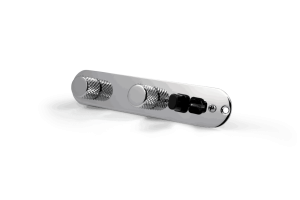
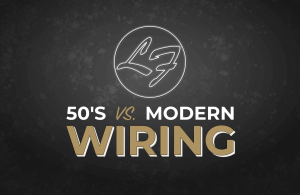

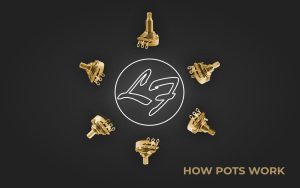


I have an Epiphone electro acoustic, with an active pickup, I run it through a Marshall AS50D amp, trouble is I get a most annoying hum, Marshall say it is a guitar grounding problem. I also have a vintage (1975) Martin D35, I use a Seymour Duncan ‘Woody’ when I’m gigging, it doesn’t hum ar all. Any suggestions.
Hey Chris,
Sorry for the delay. Honestly, take your guitar to a luthier to have it checked out! They should be able to fix the issue relatively quickly.
My wife bought me a Strat when I bought her an engagement ring. It developed a godawful buzz hum thing and got sidelined. I decided to try and sort it out and read this – the 80s engineers had soldered a wire joining all the pots and shielded it. Desoldered it just now and it is a miracle. Thank you, I’d never have sorted without the clarity of this article.
My wife bought me a Strat when I bought her an engagement ring. It developed a godawful buzz hum thing and got sidelined. I decided to try and sort it out and read this – the 80s engineers had soldered a wire joining all the pots and shielded it. Desoldered it just now and it is a miracle. Thank you, I’d never have sorted without the clarity of this article.
Hi, to extend this theory –
The Telecaster Control Plate pictured below is connecting all electronics. By connecting only one ground wire from the Volume Pot to the Output Jack, you ground your parts thoroughly.
Why wouldn’t I connect the output jack cable to one of the control panel bolts with a ring terminal,
this would save the ugly soldering of the volume pot?
” In part, the Guitar’s Ground Connection helps remove unwanted noise, and is essential for safety – It allows electricity to travel safely to the amp to dissipate. ” (quoted from the above section “The Basics”)
Could you give a real world example that backs-up the “a string ground is essential for electrical safety”? This is something I hear repeated a lot, but I don’t believe there is evidence for this claim.
Say that a mic is electrically “hot” (through a wiring/PA amp malfunction), and you touch the mic with one hand, while touching your guitar strings (which are grounded) with the other hand. BAM electricity flows right across your heart and you dead.
If the guitar strings had not been grounded, that voltage in the “hot” mic would have no where to flow (unless maybe our guitar player were barefoot, and stepping on just the wrong thing).
Next scenario: Your malfunctioning/plugged into a badly wired outlet amp is putting voltage down the guitar cord, just itching to find ground. If you do not have a string ground, there is no connection between that errant voltage and the player (although if he touches the output jack or metal knobs/pot shafts, he is then making contact with a “hot” surface).
The installation manual for EMG pickup state that a string ground should not be connected with their active pickups, and goes on to state that this lack of string ground is actually safer (see #4, under “Installation Notes”):
https://web.archive.org/web/20120306061014/http://www.emgpickups.com/content/wiringdiagrams/H_0230-0106D.pdf
I can’t think of a single scenario where having the strings on my guitar grounded makes it safer then if its strings had no connection to ground, but perhaps you can.
Dale
Hi all,
I am about to wire a telecaster project, composed as follows:
– 2 single coils (coil tapped)
– 1 vol (pushpull)
– 1 tone
– 3 way switch
– shielded cavities
I have 2 questions/doubts, hope anyone is going to finally solve them for me.
a. shielding doubt. Bridge pickup has a copper base and the bridge pickup cavity is just a tiny bit wider than the copper plate. If I shield the cavity with copper adhesive foil, there are chances that the PU’s copper plate will touch the foil. Will this be a source of problems? (same doubt for the neck’s pickup cover).
b. grounding doubt. If the above (a) would not be an issue, guitar bridge would be grounded enoug via the copper foil coming out from the bridge cavity?
Any advice would be gratefully appreciated!
Hey Francois,
I apologize for the late reply to this question (very late!) but I thought it was a fantastic question and I’d like to address it here.
The Steel Plate (it looks copper) actually helps ground the bridge assembly together. It does so by the pickup itself – take a look underneath the Bridge Pickup. You should see a jumper wire from the Steel Plate to the black lead eyelet. When you solder the black lead from the Bridge Pickup to ground, the Steel Plate gets grounded as well. So do the mounting screws that thread into it. And thus the entire bridge assembly, including the saddles and strings becomes grounded together.
It won’t hurt if the Steel Base Plate connects with your shielding. Concerning your shielding: you can either solder a jumper wire to ground to the shielding itself, or, “spill” enough above the cavity to make contact with the Bridge assembly. What’s better is up for debate, but I’d go the solder route personally.
Hope that helps!
So you shouldn’t run grounding wires from the pickup selector switch and output jack if they are making contact with copper foil that’s touching the potentiometer that has the bridge ground wire soldered to it?
I’m having some noise issues with a humbucker loaded guitar and I’m wondering if this is the cause.
Hey Fabrizio. I would try bypassing all the pots on your Tele and going straight from the 3 way to the stereo jack. Ground the pickups straight to the sleeve on the jack. If you now have no bleed, start adding pots back to the circuit until you find the culprit. I’m assuming both p’up are grounded to the back of a pot, so they are sharing the same ground regardless of stereo cable or 2 mono cables. I’d start there. Good luck.
Warren
[email protected]
I got a fender player bass and opened it up to replace the pickups and noticed that there’s an extra ground wire coming off of the jack that wasn’t soldered to anything. What’s with that, and should I connect it to one of the pots?
When I touch the outside poles of the top pickup I hear a very noticeable buzz. The two inner poles buzz but it’s not as loud.
Hi There,
I have a custom Jazzmaster that I just got and decided to add a copper pickguard shield to help with static buildup on the pickguard. So far so good-next, I decided to shield all the cavities with copper foil tape to get things as quiet as possible. My problem now if that only 1 circuit works-I get all three pickup combos, but the neck circuit(it’s specially wired)is not getting signal. However, when I loosen the screws near it, the signal comes back but then shuts off if you press down on the pickguard and make contact with the pickguard and the body again. I checked all continuity with my multimeter after soldering a jumper from the foil shielding to the back of the volume pot, and all was connected between the body and pickguard and everything else-I can’t figure this out!
Hey Jamey,
Thanks for writing in.
This could be a few things, but due to special wiring, its hard to diagnose it over email. I would start with the neck circuit. I would trace the output of the neck pickup and see where it’s getting shorted out.
As always, if all else fails, please take the guitar to a wiring specialist for a quick diagnosis.
Tyler
If you look at vintage telecasters, Leo Fender era, pre cbs guitars, the output ground is hooked from tone pot, but ground wires from pickups is solder to volume pots. What can you say about that?
This still works fine – you have a common grounding ‘point’ (Volume Pot) all heading towards the output jack. It seems like everything is grounded once, which is the goal.
Hi. I have a strat american deluxe with N3 pickups and s1 switch. My S1 switch is broken and my neck pickup also. I replace them with standard 250k volume pot and put N4 at the neck position and make a standard wiring. But I have a strange problem. When i put only the neck pickup at the pickguard sometimes getting quieterand after I pressed it it starrt working. After I screw the bickguard to body only the neck pickup cuts out. There is no shielding and cable don`t touch ground or anything.
I have a 2015 Gibson Les Paul special DC. One volume and one Tone pot. I replace my P-90’s with Lindy’s Hum canceling P-90’s. I was going to paint all my cavities ” Pots and pickup wholes” with conductive paint from Stew Mac I was worried about about the ground loop problem. So I haven’t done that yet. My question is is it ok to do it. “As long as the pots are not looping I guess”. Right now I have very little noise coming from either P-90 I’m Loving the sound over the stock Gibson P-90’s
It’s okay to do it, just make sure it’s being grounded in only one place, like a screw with a wire going to the back of the Volume Pot. You can run into trouble with a Strat, for example – you’ll see conductive shielding on the back of the pickguard in contact with the paint in addition to a wire – this forms a loop. So, as long as you’re avoiding these sorts of issues, you’re good to go.
On a 4 way switch tele, should the bridge plate on be grounded to the volume pot? I know the neck pickup cover must be grounded separately. Thanks.
Hey John,
The Bridge Pickup itself usually grounds out the Bridge Plate by the mounting screws of the Bridge Pickup. The Pickup has a steel plate underneath that the screws thread into that is connected to ground. No additional grounding is required. I hope that helps!
What do you think about the vintage style grounding plates on a Les Paul? Since those plates touch all pots, does that sometimes cause issues? The reason I ask is because I have an 82 Custom with a plate that is dead silent even when I am not touching the strings/bridge. My 84 with a plate has a very noisy buzz unless I touch the pickup cover. Neither has a ground going to the bridge post and I can’t figure out why there is a difference. Wiring appears to be the same on both.
Hey Anthony,
I haven’t had any direct experience with those grounding plates, but everything I’ve read about makes it seem that people find the tone better with the plate removed. If anyone else could comment, that would be nice.
That pickup cover has a broken ground somewhere in the chain. You can find it by holding the cover with a multimeter, and begin by touching all other metal down the chain to find the broken link.
Hope that helps,
Tyler
Buzz that reduces when he touches the pickup cover actually indicates that the cover ground is fine.
Just diagnosed and fixed a buzz on the neck pickup of my les Paul thanks to this article. Sounds soooooo incredibly good now. Thanks so much!
Right on! That’s what we like to hear. 🙂
Could you do a video on your youtube channel to prove your LP / tele ground loop theories please ? First with the loop in place, and then with it cut ? Let’s hear the hum difference. Otherwise, there are electrical engineers who argue that you cannot get a hum-producing ground loop in a guitar (not just a physical loop). Let’s decide this argument once and for all. Some measurements would be good (I’m sure you have an oscilloscope), the main thing is to hear any difference.
Hey TB,
This would be a task for someone else to do! We are too busy making pickups 😉
Hello Tyler,
I’m a courious guy with special needs. I wanted to modify my guitar so that I can make it sound like a normal guitar and a bass at the same time.
So, I’ve modified my telecaster’s wiring so that I use a stereo jack where my neck pickup signal goes to it’s ring while the bridge pickup signal goes to it’s tip. As ground is common for both I’ve put their ground in the jack’s sleeve.
I use a stereo cable with stereo jack in one side and a “Y” end on the other side that separates signals in mono jacks as it follows:
1-the bridge pickup signal goes to my pedal board straight to a guitar amplifier (this is my normal guitar sound)
2-the neck pickup signal goes through a octave down pedal straight to a bass amplifier (this is my bass sound)
I use the tele 3 way switch to control this “system” so that I can have only guitar(bridge pickup to the guitar amp), only “bass”( octave downed neck pickup to bass amp) or both at the same time.
This solution works fine, but I can hear a little bit of the bridge pickup sound on the bass amp and a little bit of the neck pickup sound on the guitar amp.
I’ve doubled checked wiring and it seems ok to me. Do this happen because the ground is common for both pickups? If yes, is there anyway to avoyd this “sound bleed” without having to instal an extra mono jack in my telecaster? I don’t want to drill an extra hole and work with two cables.
Thanx in advance!
Regards
Fabricio Barreto
Quebec City – Canada
I have split rails in 2 of my guitars, they sound great except for this Sparkle when I touch certain spots around the pickups or pick guards. My Tele you just have to tap the pick guard. It’s hot a continuous noise, it occurs when first touch like you should get shocked when it happens. Very frustrating
Steve,
Sounds frustrating. Definitely sounds like something is not grounded properly – do you happen to have a metal pickguard, or conductive paint?
Hi, Steve and Tyler.
I’ve dealt with this issue a couple of times over the last ten years. Customers have complained, it’s rare, that when they touch or rub a certain area of a pickguard, strat or tele, that it makes a static like noise or crackling through to the amp. The first time this occurred I got the guitar to my bench and tried every way I could think of to properly ground the guitar. The pickguard would still make a crackling sound through the pickups when rubbed on a certain spot. It was the weirdest thing I’d ever heard. I asked my mentor if he’d ever heard of it and he said that he had on rare occasions. His suggestion? Rub the pickguard with a dryer sheet! I rolled my eyes but I went ahead and tried it because he was serious. So, the dryer sheet did temporarily eliminate the static sound. At that point I knew that the pickguard had some weird way of making static, probably by being delaminated internally at the problem area. The long term fix was to put a new pickguard on the guitar. I didn’t mess around the next time I heard of a similar issue. I advised the guy to swap the pickguard which he did and the problem was solved. So, Steve, I recommend that you change out your pickguards. I hope this helps. I know it sounds crazy! I thought about it for a long time before I posted this.
Jimmy
Great tip! Thanks for sharing, Jimmy!
I installed a lace sensor gold in my acoustic. Single volume to jack. Easy right? Well there is a buzz that will not go away no matter what i try. Properly wired and grounded. White green tied and grounded and orange to hot. All good but still a buzz. Any ideas? Ive done this many times and never had this problem.